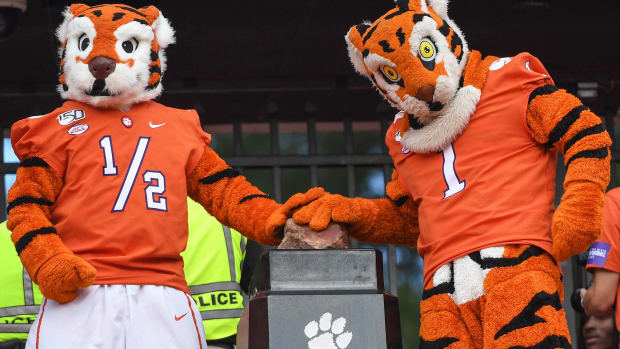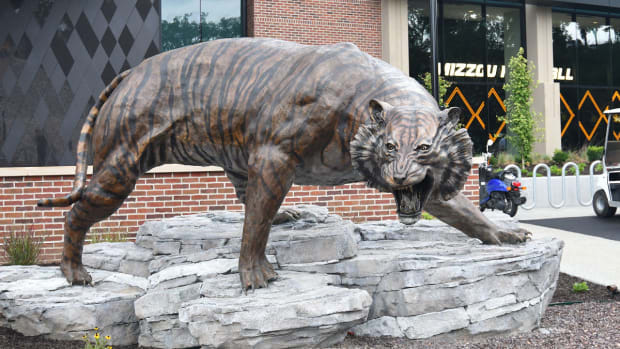Whether for good or bad reasons, these college football stadium iconographies are hard to forget.
Forty names, games, teams and minutiae making news in college football (Willie Taggart scapegoating kits sold separately in Tallahassee):
MORE DASH: Big 12's Rough Start
SECOND QUARTER: HOW BIG IS YOUR CHICKEN?
By SEC standards, South Carolina has historically been a quart low on crazy. There just haven’t been as many you-must-be-joking headlines from Columbia as other places in the league, when it comes to fans who have completely lost perspective on football.
But now, nearly three decades after joining the most ridiculous league in the U.S., the Gamecocks are upping the dose with a big bronze bird. This season they will unveil a 20,000-pound Giant Flapping Chicken statue (11) outside Williams-Brice Stadium.
"We needed something iconic," said David Seaton, one of the South Carolina alums who paid the $1 million price tag for the monstrosity. The Dash’s life goal is to have that kind of money to spend on a deeply weird sculpture of a fighting rooster.
It is, without a doubt, the most absurd thing any school has ever designated as stadium iconography. But it did provoke a Dash list of the best and worst accoutrements at America’s houses of gridiron worship.

THE BEST
Howard’s Rock (12), Clemson. You’ve seen the Tigers rub the rock before running down the hill into their stadium, one of the best pregame traditions in the sport. The backstory: The rock, which came from the actual Death Valley in California, was given to then Clemson coach Frank Howard in honor of the stadium’s nickname. Howard had the rock mounted on a pedestal in 1966, and the players began rubbing it in ’67. More than half a century later, they’re still doing it.
Play Like a Champion Today sign (13), Notre Dame. Located in a stairwell that leads from the locker room to the field at Notre Dame Stadium, the Fighting Irish players slap it on their way out. This one dates to 1986, a creation of Lou Holtz not long after he arrived as coach.
Kentucky pioneering player statue (14). In 1967, Nate Northington became the first Black football player in the SEC. He was one of four Black people on that Wildcats team, along with Greg Page, Wilbur Hackett and Houston Hogg. The barrier-breaking quartet had a star-crossed Kentucky experience—Page died the night before Northington broke the league color barrier, more than a month after he broke his neck in a practice drill. Northington wound up leaving Kentucky a few weeks later, transferring to Western Kentucky. Hackett and Hogg had more substantial playing careers as Wildcats, with Hackett becoming the first Black football team captain in the SEC in 1969. The statue was unveiled in 2016.
Pat Tillman statue (15), Arizona State. The former ASU star turned Arizona Cardinals star turned enlisted Army Ranger is memorialized in Sun Devil Stadium. Several months after the 9/11 attacks, Tillman left millions of dollars on the table at age 25 to join the Army. He was deployed to Afghanistan and died there in 2004 as the victim of friendly fire. The ASU statue of Tillman, helmeted and in uniform, is life-sized. While it’s unlikely that Tillman would be thrilled by a statue of himself, he would at least approve of the normal proportions.
Nile Kinnick statue (16), Iowa. The 1939 Heisman Trophy winner was a two-way star on the Hawkeyes’ “Ironmen” team, throwing 11 touchdown passes and leading the nation in interceptions with eight. His season included a game-winning TD pass on the final play against Indiana and other heroic scores while playing 402 consecutive minutes. Upon graduation, Kinnick turned down a pro contract to go to law school and ultimately enlisted in the U.S. Naval Air Corps just prior to America’s involvement in World War II. In 1943 he died when the plane he was piloting crashed in the Atlantic Ocean off the coast of Venezuela.

THE WORST
With the Giant Flapping Chicken now taking over the top spot in this category, everyone else is bumped down one notch.
Wild Band of Razorbacks statue (17), Arkansas. Alum, former Hog football player and current Dallas Cowboys owner Jerry Jones funded this monument to silliness. It depicts six gigantic hogs charging off rocks and into parts unknown, with a waterfall component that pumps 13,000 gallons of water through the thing. There is a plaque attached commemorating Arkansas’s 1964 national championship team, of which Jones was a member. The statue was dedicated in 2018, and it should be noted that Arkansas has not won an SEC game since then. The Curse of the Hog Statue is real, man.
Missouri Tiger (18). This sculpture was part of a South End Zone building project that was completed last year. Unfortunately, nobody told the artist what a tiger actually looks like. The one Mizzou got looks more like a web-footed wolf.
Shasta the Cougar (19), Houston. Are you detecting a trend here? The Dash is not a huge fan of statues of mascots. What, pray tell, is the point? Shasta was the name given to Houston’s original live-mascot cougar, and all subsequent successors. A mishap involving the original Shasta led to Houston’s current hand sign (every Texas school must have a hand sign, for whatever reason). One of her toes allegedly was sliced off en route from Houston to Austin for the school’s first football game against Texas, and at that game Longhorns fans held up three fingers with the ring finger pulled down by the thumb—signifying Shasta’s missing digit. Eventually, this replaced the “V” symbol as the Houston hand sign. And they are picky about how it’s done (right hand only, it says here).
Missing Joe Paterno (20), Penn State. In July 2012, the school stealthily removed the JoePa statue that had become a flashpoint on campus, moving it to a secure location that remains an intensely guarded secret in State College. One of the problems of erecting statues to people who are not only still living but also working—especially in the highly fallible realm of college athletics—is that reputations can change over time. And not often for the better. Thus a beloved figure can become a disgraced icon when it was discovered that he had a monstrous pedophile on his staff for years. Joe had to go as coach of the Nittany Lions, and then Joe the statue had to go as well. Somewhere.
MORE DASH: Big 12's Rough Start